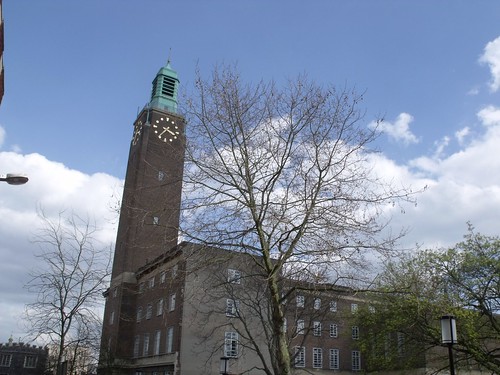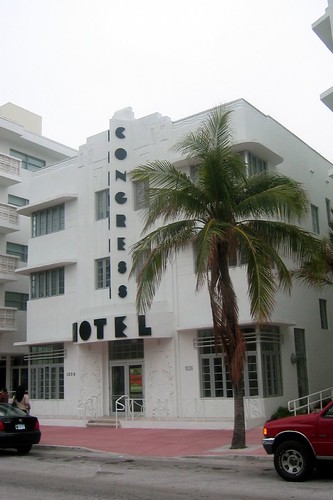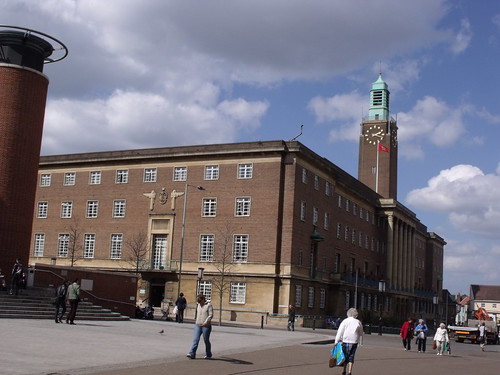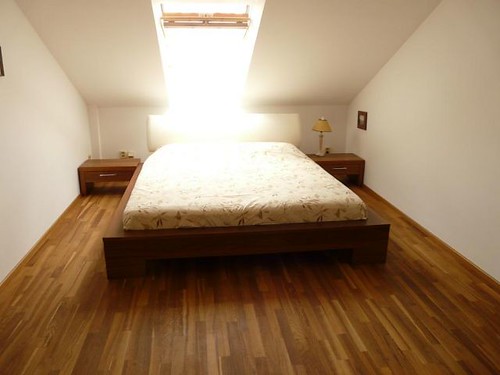City Hall, Norwich from St Giles Street
Image by ell brown
This is City Hall in Norwich. The home of Norwich City Council. It is near the markets.
I think it was built to replace the old Guildhall nearby, as it was too small for the local political needs of Norwich.
Taken from St Giles Street.
It is an Art Deco building finished in 1938. Designed by the architects Charles Holloway James and Stephen Rowland Pierce, after Robert Atkinson had prepared a layout for the whole Civic Centre site at the request of Norwich City Council.
It was opened in 1938 by King George VI and Queen Elizabeth.
It is a Grade II* listed building.
City Hall with attached police station. 1932-38 by C. H. James and S. R. Pierce. Brick with stone dressings, lower 2 storeys of stone. Flat roof. 5 storeys, with tower to right-hand side. Twenty-five 4th floor windows. Central entry with 6 polygonal columns above rising from the first-floor balcony and supporting entablature. Triple doors and steps up flanked by lions. Metal casement windows with glazing bars throughout. Small semi-circular balconies in penultimate end bays with small fan-lights above doors. The three end bays project. Parapet. Square clock tower topped with square cupola and finial. The exterior also has applied and freestanding sculpture in stone and stone. The bronze lions either side of the main stairs are by Alfred Hardiman, and the three pairs of main bronze doors with 18 plaques depicting Norwich history and trades were sculpted by James Woodford. The Bethel Street façade has the entrance to the Rates Hall with a stone relief panel of the City arms by Eric Aumonier who was also responsible for London Underground station sculpture. The former entrance to the Police Station within this wing has an ornate bronze lantern and relief stone panels depicting police helmets by H. Wilson Parker. The left of the wing, the police station, was extended 1965-7 in a similar style by the City Architect, David Percival. The north wing was unfinished but the Council Chamber projects to the rear in the middle of the main range and the wall facing the rear has, as well as decorative brickwork, three tall narrow niches from which project sculptures also by Alfred Hardiman of Recreation, Wisdom and Education.
INTERIOR: The extremely impressive interior includes an entrance hall with stone and marble clad walls and columns, stairs lit by a window with textured engraved and painted glass and a ceiling painting designed by Eric Clarke and painted by James Michie. The hall above is also marble clad, and leads to a long suite of committee and reception rooms including the Lord Mayor's parlour. This suite stretches all along the main front and there is a long (365') balcony outside and most rooms are finely panelled with various varieties of wood, including inlay, and have original fine fireplaces, fittings and textiles. The Lord Mayor's Parlour is very fine being an octagon with shallow vaulted ceiling and fully panelled in sycamore with the veneers cut using the highest expertise to produce a brilliant effect of intensely rich dado figuring and lighter cloud-like wall figuring. In addition the Council Chamber itself is very fine with curving seating in mahogany with inlaid brass edges and mahogany entrance wall columns, and also wall panelling to half height with a variety of panel designs. Many light fittings which were designed for the building by the architects also survive.
Other elements of the fine interior include the third floor hall with lift entrance, lantern and balcony, all in austere classical Art Deco styling, and the former marriage suite on the lower ground floor.
HISTORY:
Norwich City Hall was designed in 1931 and built in 1937-8. The design by the architects James and Pierce was the winning entry in a public competition which attracted 143 entries. The there had long been felt a need for a fitting city hall and an area to the north of the market place was cleared to provide a suitable space which would be still at the very centre of the city. Following discussions with the R.I.B.A., Robert Atkinson was appointed as the supervisor of the development of the Market Place and produced his own plans. In the end there was competition with Atkinson as the sole judge and his ground plan was retained as one of the many conditions.
SUMMARY OF IMPORTANCE:
Norwich City Hall is one of the landmarks of the city and one of the finest municipal buildings of the interwar period in England. It is in an austere Classical style with Art Deco detailing and makes reference also to Scandinavia and in particular Stockholm City Hall. The prominent tower contrasts successfully with the long principal front standing above the sizeable Market Place. The exterior is very impressive, being on 5 storeys with a prominent portico and applied and freestanding sculpture in stone and bronze. The interior is also impressive with a long suite of committee and reception rooms including the Lord Mayor's Parlour. The rooms are finely panelled with various varieties of wood and original fine fittings and textiles. In addition the Council Chamber itself is very fine with curving seating in walnut with inlaid brass edges and wall panelling to half height with a variety of panel designs. The sculpture and plaques in bronze and stone include work by Alfred Hardiman and Eric Aumonier. The totality of the exterior and interior, complete with fine sculpture in stone and bronze and the finest interior fittings in contemporary style, is particularly successful.
City Hall, Norwich - Heritage Gateway
Miami Beach - South Beach: Congress Hotel
Image by wallyg
The Congress Hotel, at 1024 Ocean Drive, was designed by Henry Hohauser and opened in 1936. Typical of the South Beach art deco style, it has a three-part front and both vertical and horizontal elements--the tall sign with an Art Deco font and relief floral and abstract motifs emphasizing the vertical while the continuous eyebrows, fenestration, and canopy with "HOTEL" are emphasizing the horizontal. The central bay is topped with a sort of ziggurat.
In 2005, the Congress Hotel was joined together toward the rear with four other properties to form the Strand--J. Meyer's 1964 Ben-Stan, M. Tony Sherman's 1950 Waves Apartment, Henry J. Moloney's 1934 Bon Air, and Kobi Karp Architectur's 2005 Strand.
The Miami Beach Architectural District, also known as Old Miami Beach Historic District, or the more common, Miami Beach Art Deco District, is roughly bounded by the Atlantic Ocean, Alton Road and Collins Canal/Dade Boulevard and 5th Street. With 960 vibrantly colored historic buildings, it contains the largest concentration of 1920s and 1930s resort architecture in the United States.
Miami Beach Architectural District #79000667 (1979)
City Hall, Norwich
Image by ell brown
Took this shot while heading past The Forum. The markets are to the right, as is the Church of St Peter Mancroft.
This is City Hall in Norwich. The home of Norwich City Council. It is near the markets.
I think it was built to replace the old Guildhall nearby, as it was too small for the local political needs of Norwich.
It is an Art Deco building finished in 1938. Designed by the architects Charles Holloway James and Stephen Rowland Pierce, after Robert Atkinson had prepared a layout for the whole Civic Centre site at the request of Norwich City Council.
It was opened in 1938 by King George VI and Queen Elizabeth.
It is a Grade II* listed building.
City Hall with attached police station. 1932-38 by C. H. James and S. R. Pierce. Brick with stone dressings, lower 2 storeys of stone. Flat roof. 5 storeys, with tower to right-hand side. Twenty-five 4th floor windows. Central entry with 6 polygonal columns above rising from the first-floor balcony and supporting entablature. Triple doors and steps up flanked by lions. Metal casement windows with glazing bars throughout. Small semi-circular balconies in penultimate end bays with small fan-lights above doors. The three end bays project. Parapet. Square clock tower topped with square cupola and finial. The exterior also has applied and freestanding sculpture in stone and stone. The bronze lions either side of the main stairs are by Alfred Hardiman, and the three pairs of main bronze doors with 18 plaques depicting Norwich history and trades were sculpted by James Woodford. The Bethel Street façade has the entrance to the Rates Hall with a stone relief panel of the City arms by Eric Aumonier who was also responsible for London Underground station sculpture. The former entrance to the Police Station within this wing has an ornate bronze lantern and relief stone panels depicting police helmets by H. Wilson Parker. The left of the wing, the police station, was extended 1965-7 in a similar style by the City Architect, David Percival. The north wing was unfinished but the Council Chamber projects to the rear in the middle of the main range and the wall facing the rear has, as well as decorative brickwork, three tall narrow niches from which project sculptures also by Alfred Hardiman of Recreation, Wisdom and Education.
INTERIOR: The extremely impressive interior includes an entrance hall with stone and marble clad walls and columns, stairs lit by a window with textured engraved and painted glass and a ceiling painting designed by Eric Clarke and painted by James Michie. The hall above is also marble clad, and leads to a long suite of committee and reception rooms including the Lord Mayor's parlour. This suite stretches all along the main front and there is a long (365') balcony outside and most rooms are finely panelled with various varieties of wood, including inlay, and have original fine fireplaces, fittings and textiles. The Lord Mayor's Parlour is very fine being an octagon with shallow vaulted ceiling and fully panelled in sycamore with the veneers cut using the highest expertise to produce a brilliant effect of intensely rich dado figuring and lighter cloud-like wall figuring. In addition the Council Chamber itself is very fine with curving seating in mahogany with inlaid brass edges and mahogany entrance wall columns, and also wall panelling to half height with a variety of panel designs. Many light fittings which were designed for the building by the architects also survive.
Other elements of the fine interior include the third floor hall with lift entrance, lantern and balcony, all in austere classical Art Deco styling, and the former marriage suite on the lower ground floor.
HISTORY:
Norwich City Hall was designed in 1931 and built in 1937-8. The design by the architects James and Pierce was the winning entry in a public competition which attracted 143 entries. The there had long been felt a need for a fitting city hall and an area to the north of the market place was cleared to provide a suitable space which would be still at the very centre of the city. Following discussions with the R.I.B.A., Robert Atkinson was appointed as the supervisor of the development of the Market Place and produced his own plans. In the end there was competition with Atkinson as the sole judge and his ground plan was retained as one of the many conditions.
SUMMARY OF IMPORTANCE:
Norwich City Hall is one of the landmarks of the city and one of the finest municipal buildings of the interwar period in England. It is in an austere Classical style with Art Deco detailing and makes reference also to Scandinavia and in particular Stockholm City Hall. The prominent tower contrasts successfully with the long principal front standing above the sizeable Market Place. The exterior is very impressive, being on 5 storeys with a prominent portico and applied and freestanding sculpture in stone and bronze. The interior is also impressive with a long suite of committee and reception rooms including the Lord Mayor's Parlour. The rooms are finely panelled with various varieties of wood and original fine fittings and textiles. In addition the Council Chamber itself is very fine with curving seating in walnut with inlaid brass edges and wall panelling to half height with a variety of panel designs. The sculpture and plaques in bronze and stone include work by Alfred Hardiman and Eric Aumonier. The totality of the exterior and interior, complete with fine sculpture in stone and bronze and the finest interior fittings in contemporary style, is particularly successful.
City Hall, Norwich - Heritage Gateway
City Hall, Norwich - Tower from St Giles Street
Image by ell brown
This is City Hall in Norwich. The home of Norwich City Council. It is near the markets.
I think it was built to replace the old Guildhall nearby, as it was too small for the local political needs of Norwich.
The tower of the City Hall from St Giles Street, with 1930s clock face and topped off in copper.
It is an Art Deco building finished in 1938. Designed by the architects Charles Holloway James and Stephen Rowland Pierce, after Robert Atkinson had prepared a layout for the whole Civic Centre site at the request of Norwich City Council.
It was opened in 1938 by King George VI and Queen Elizabeth.
It is a Grade II* listed building.
City Hall with attached police station. 1932-38 by C. H. James and S. R. Pierce. Brick with stone dressings, lower 2 storeys of stone. Flat roof. 5 storeys, with tower to right-hand side. Twenty-five 4th floor windows. Central entry with 6 polygonal columns above rising from the first-floor balcony and supporting entablature. Triple doors and steps up flanked by lions. Metal casement windows with glazing bars throughout. Small semi-circular balconies in penultimate end bays with small fan-lights above doors. The three end bays project. Parapet. Square clock tower topped with square cupola and finial. The exterior also has applied and freestanding sculpture in stone and stone. The bronze lions either side of the main stairs are by Alfred Hardiman, and the three pairs of main bronze doors with 18 plaques depicting Norwich history and trades were sculpted by James Woodford. The Bethel Street façade has the entrance to the Rates Hall with a stone relief panel of the City arms by Eric Aumonier who was also responsible for London Underground station sculpture. The former entrance to the Police Station within this wing has an ornate bronze lantern and relief stone panels depicting police helmets by H. Wilson Parker. The left of the wing, the police station, was extended 1965-7 in a similar style by the City Architect, David Percival. The north wing was unfinished but the Council Chamber projects to the rear in the middle of the main range and the wall facing the rear has, as well as decorative brickwork, three tall narrow niches from which project sculptures also by Alfred Hardiman of Recreation, Wisdom and Education.
INTERIOR: The extremely impressive interior includes an entrance hall with stone and marble clad walls and columns, stairs lit by a window with textured engraved and painted glass and a ceiling painting designed by Eric Clarke and painted by James Michie. The hall above is also marble clad, and leads to a long suite of committee and reception rooms including the Lord Mayor's parlour. This suite stretches all along the main front and there is a long (365') balcony outside and most rooms are finely panelled with various varieties of wood, including inlay, and have original fine fireplaces, fittings and textiles. The Lord Mayor's Parlour is very fine being an octagon with shallow vaulted ceiling and fully panelled in sycamore with the veneers cut using the highest expertise to produce a brilliant effect of intensely rich dado figuring and lighter cloud-like wall figuring. In addition the Council Chamber itself is very fine with curving seating in mahogany with inlaid brass edges and mahogany entrance wall columns, and also wall panelling to half height with a variety of panel designs. Many light fittings which were designed for the building by the architects also survive.
Other elements of the fine interior include the third floor hall with lift entrance, lantern and balcony, all in austere classical Art Deco styling, and the former marriage suite on the lower ground floor.
HISTORY:
Norwich City Hall was designed in 1931 and built in 1937-8. The design by the architects James and Pierce was the winning entry in a public competition which attracted 143 entries. The there had long been felt a need for a fitting city hall and an area to the north of the market place was cleared to provide a suitable space which would be still at the very centre of the city. Following discussions with the R.I.B.A., Robert Atkinson was appointed as the supervisor of the development of the Market Place and produced his own plans. In the end there was competition with Atkinson as the sole judge and his ground plan was retained as one of the many conditions.
SUMMARY OF IMPORTANCE:
Norwich City Hall is one of the landmarks of the city and one of the finest municipal buildings of the interwar period in England. It is in an austere Classical style with Art Deco detailing and makes reference also to Scandinavia and in particular Stockholm City Hall. The prominent tower contrasts successfully with the long principal front standing above the sizeable Market Place. The exterior is very impressive, being on 5 storeys with a prominent portico and applied and freestanding sculpture in stone and bronze. The interior is also impressive with a long suite of committee and reception rooms including the Lord Mayor's Parlour. The rooms are finely panelled with various varieties of wood and original fine fittings and textiles. In addition the Council Chamber itself is very fine with curving seating in walnut with inlaid brass edges and wall panelling to half height with a variety of panel designs. The sculpture and plaques in bronze and stone include work by Alfred Hardiman and Eric Aumonier. The totality of the exterior and interior, complete with fine sculpture in stone and bronze and the finest interior fittings in contemporary style, is particularly successful.
City Hall, Norwich - Heritage Gateway
Prague Bedroom: Ecological and Modern Architectural Deisgn
Image by athomenetwork
Bedroom of this Prague apartment built following the method of architectural constructivism. The concept of the apartment is modern design with ecological, high quality materials combined with colorful, original art-deco elements.
See athome-network.com/SDCZ.html#!/?id=5194
No comments:
Post a Comment